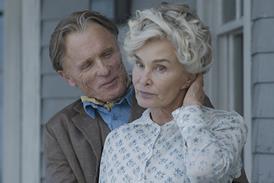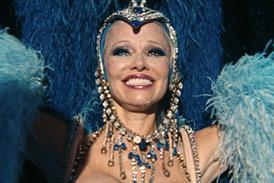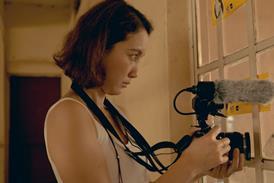Dir:Carlos Reygadas. Mex. 2005. 98mins.
Followingon the heels of his demanding but brilliant first feature, Japon,Mexican director Carlos Reygadas now bulls his way into the Cannes competitionline-up to give us another exceptionally ambitious aesthetic effort. While itdoesn't always work - and critical opinion is sure to be violently split - it'simmensely striking and quite powerful overall.
Somedistributors (and audiences) will be attracted by the film's plethora of nudityand its variety of sexual encounters, but presented as they are in Reygadas'trademark warts-and-all fashion, they will surely turn off those whoseinterests are primarily prurient. Discerning viewers able to transcend thislevel, however, will discover the same attempt to convey an authenticity ofbeing that was the hallmark of Italian neo-realism. What Reygadas adds to themix is an intense viscerality that seems utterly new.
Theplot is simple and, frankly, not very believable, especially given the way it'stossed out at odd moments in random lines of dialogue. The film opens as thefat and not very attractive Carlos (Hernandez), chauffeur for a general, headsto an airport to pick up his employer's beautiful daughter Ana (Mushkadiz).
Sheasks instead to be delivered to the brothel she secretly works in; Carlosreveals to her that he and his wife (Ruiz) have kidnapped the baby of a friendin order to extort ransom money. Alas, the baby has died and Carlos is wrackedwith guilt, though this does not keep him from having sex with Ana.
Bythe end, he has joined a religious procession, hooded and on his knees, to theBasilica of Our Lady of Guadalupe, the Mexican national shrine, in order toseek spiritual relief.
Forthe most part the actors seem to be non-professionals, with the exception ofMushkadiz chosen for their expressive physiognomy and richly corpulent bodiesrather than for any presumed acting ability. Like the neo-realists, Reygadasseeks to put being itself on display, and revels especially in the truth of thehuman body. To achieve this, he peppers his film with a steady stream ofclose-ups, as often on extraneous parts of the body - say, a waist or ashoulder - as on the more traditional face shots.
Thereligious longings expressed in the film recall Rossellini's similar mix ofrealism and spirituality in The Miracle and in Stromboli, whichhad the admittedly easier to look at Anna Managni and Ingrid Bergman at theircentres.
Atthe same time, though, this ultra-realism results in a kind ofhyper-artificiality that produces an obviously purposeful stylised effect. Herethe prototype seems to be Antonioni more than Rossellini, and this is nowhereclearer than in a gorgeous shot late in the film when Carlos disappears into abank of fog, like Monica Vitti in Red Desert.
Alsolike Antonioni, Reygadas relies on the expressive power of images, on thegraphic meaning of shapes and forms, even if they are not clearly motivated bythe narrative or psychological realism. Similarly, he is unafraid to insertovert (some might say heavy-handed) symbolism, like some bells that fail toring, when needed.
Thefilm is structured around a set of various oppositions. Starting with crowdedcityscapes of an apparently unliveable Mexico City, it then moves in the secondhalf into some breathtaking landscapes of the countryside. A 360-degree shot ofthe city is rhymed by a similar shot later in the mountains.
Thereis also an opposition between youth and beauty, on the one hand, represented byAna, and old age and ugliness, on the other, represented by Carlos and hiswife. The explicit sex scenes throw these oppositions so violently in viewers'faces that many will be revolted, but perhaps even more will welcome the turnaway from the even more depressing unreality of Hollywood glamour.
Evenmore interesting is the socio-political critique that the film subtly sketches.Shots of the military are seen throughout the film, and all the religiousimages are accompanied by symbols of the state, principally the Mexican flag,in a way that recalls Eisenstein's linking of these two entities in someclose-ups in Battleship Potemkin.
It'sunclear, however, exactly what Reygadas' political point is, other than toimply that what we have seen in the first half of the film (kidnapping,prostitution, urban anomie) is somehow related to what we see in the secondhalf, the pomp of state and religion (along with national football) intertwinedto keep the masses from taking more forceful steps to end their misery. (Thereligious song we hear near the end expressly asks for 'peace' for the poorrather than justice.)
Manyof Reygadas' effects are ostentatious, and it's clear that he does not lack forartistic self-confidence. For example, the very opening shot, a close-up onCarlos' face that gradually moves backward to reveal that he is being fellatedby Ana, is accompanied by an overwrought passage in the musical score thatcalls too much attention to itself. At another moment, he seems to be tauntingthe audience by blasting Bach during a scene at a petrol station, only toreveal that the sound is coming from the station itself.
Still,the very gutsiness and ambition on display here are surely better than thetepid television movies that sometimes pass for art films at Cannes. Better totry for something and fail than never to try at all.
Productioncompanies
Mantarraya Producciones
No Dream Cinema
Tarantula
Internationalsales
The Coproduction Office
Producers
Phillipe Bobe
Carlos Reygadas
Jaime Romandia
Susanne Marian
Cinematography
Diego Martinez Vignatti
Screenplay
Carlos Reygadas
Ed
Benjamin Mirguet
Adoracion G Elipe
Nicolas Schmerkin
Music
John Tavener
Maincast
Marcos Hernandez
Anapola Mushkadiz
Berta Ruiz



















No comments yet